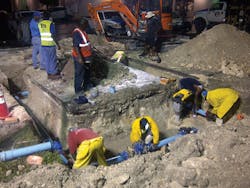With a non-revenue water rate of 58% and many failed attempts to improve its water network, the Bahamas' Water and Sewerage Corporation has embarked on a 10-year plan improvement plan. Together with an education campaign, the plan aims to win back local resident support.
By Paul Fanner
With an eye on the goal of making its water supply system more efficient, the Bahamas Water and Sewerage Corporation (WSC) is making a bold move with a ten-year comprehensive water efficiency project. Starting in April 2012, it was funded by an Inter-American Development Bank (IDB) loan.
WSC supplies drinking water to 250,000 residents in New Providence. Non-revenue water levels in the system were very high in 2012, with about 58% of the water entered into the utility's distribution system lost before ever reaching customers.
In quantifiable numbers, this means that over 31,000 m3/day of water flow out of the system without ever reaching customers. Although surrounded by water, very little is fresh for drinking, so 90% of the islands' water comes from desalination plants, an expensive prospect. Reducing water losses was an urgent problem for WSC.
The project will not only work to tackle the problem of non-revenue water (NRW) – the gap between the amount of water put into the system and the amount that actually reaches customers – but will also work on fixing the relationship between the utility and its customers. This will be through community education and awareness efforts, a public win-back campaign and long-term infrastructure planning to ensure the future efficiency of the system as well.
Reducing NRW is a challenging prospect. In most countries, water utilities are part of the public sector, and day-to-day problems cloud the need for major infrastructure projects. When utilities do embark on NRW reduction projects on their own, they often fail because they lack the know-how and experience to do them right.
Water supply systems are complex and, often, have grown and developed over the course of many years. As a result, changing any element in a water supply system affects all the other elements in the system.
"There is no right or wrong formula," says Arjun Thapan, chairman of Waterlinks, Inc. and former special advisor on Infrastructure and Water to the Asian Development Bank President.
"A solution that fits one metropolis does not fit the other, and the right mix needs to be determined by experts."
For three decades, there had been limited success in coping with increasing levels of NRW in the Bahamas, which is what inspired the WSC to turn to Miya.
As WSC general manager Glen Laville summarizes: "Several solutions were tried over the years using internal and external resources. Nothing made our network more efficient, because every action had its benefits and consequences."
Partnering with Miya, the WSC embarked on a comprehensive long-term approach to reduce NRW and maximize the efficiency of its water delivery system.
The project will continue until April 2022 and includes a full suite of water efficiency solutions to curb the NRW problem. The overall goal is to save more than 13,000 m3/day of water per day within five years. Miya aims to significantly improve the client's financial and operational efficiency, but these are not their only goals.
The project also includes essential elements to bolster the WSC's public image and help the company win-back customers that it has lost over the years, including a primary school water awareness and education program and extensive job training and certification for local employees.
By hiring and training Bahamians to work throughout the project, the project ensures that not only will the NRW project be carried out during its term, but also that the results achieved will be maintained by a skilled local team.
Miya's work in the Bahamas began with a baseline survey and the use of local NRW audits to design a cost-effective plan for NRW reduction.
A manual cutback system had been implemented to reduce leaks. After the installation of a new automated pressure control system, this need was eliminated. Leak detection teams were deployed into high leakage zones throughout New Providence, and have already located and repaired hundreds of leaks. At the same time, Miya and WSC began the installation of new service lines perpendicular to the existing main with updated corrosion-resistant valves.
Another highlight of the comprehensive water efficiency project is a pilot educational awareness program donated by Miya to the Bahamian community. Miya experts developed a curriculum for 5th grade students to learn about the origins and importance of water to human existence, the value of using water more efficiently, water conservation techniques, meter reading and other water-related topics.
Simultaneously with the education program, water efficient sinks and toilets were installed in the Oakes Field Primary School in Nassau, where the pilot program was conducted. By the end of the school year, a 20% reduction in water consumption was keenly calculated by the pupils themselves.
A closing competition and ceremony was organized to end the water study program on a celebratory note. Students were asked to creatively display their newly acquired water knowledge.
There were posters, videos, poems, performances and more at the June 2013 event. Students were clearly excited by what they had learned and shared it eagerly with a crowd of peers, teachers, parents and distinguished guests from the government and WSC. Community involvement is essential to strengthen the relationship between the public and the water utility. School children are a great resource for spreading the value and knowledge of water efficiency practices, to teach their peers, parents and the entire community.
The educational program was clearly a success. It's hoped that similar programmes will be implemented in schools throughout the island and display it to others as an example of a fun and effective way to involve the community in a major water efficiency program.
With lofty goals to reduce losses by millions of cubic metres a day, WSC also intends to win-back customers and have a high return on its investment, to continue well into the future. With dozens of Bahamians already working in the Miya office and employed throughout the project in the field, the project has set off on a very promising start.
The Bahamas Government, the WSC and the Bahamian community have set an example for the world of how important it is to manage our precious water resources efficiently. A forward thinking, innovative project such as this one leads to sustainable change that mutually benefits the utility and the citizens it supplies.
Paul Fanner is an international NRW expert and Miya Bahamas project director. For more information, email: [email protected].





